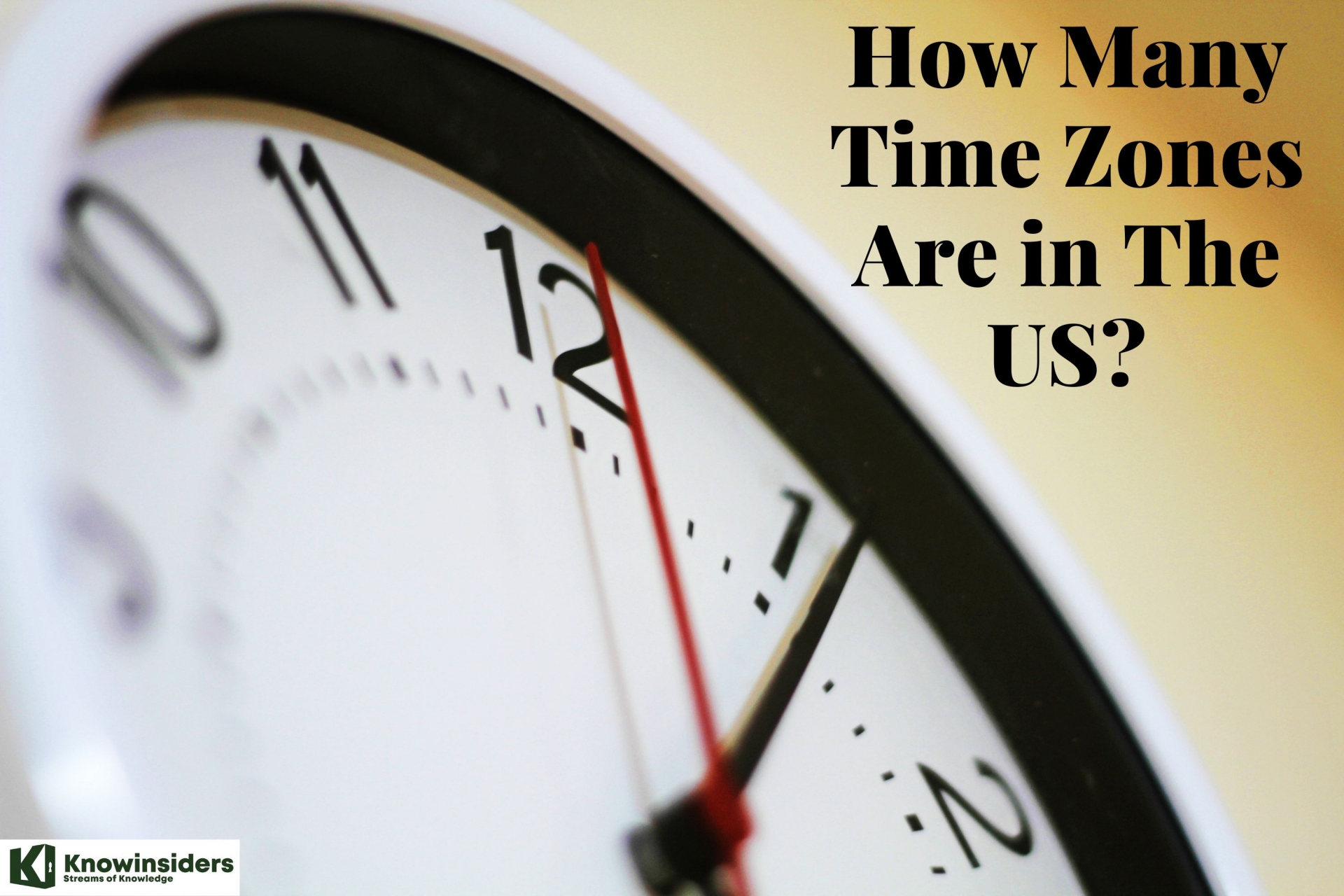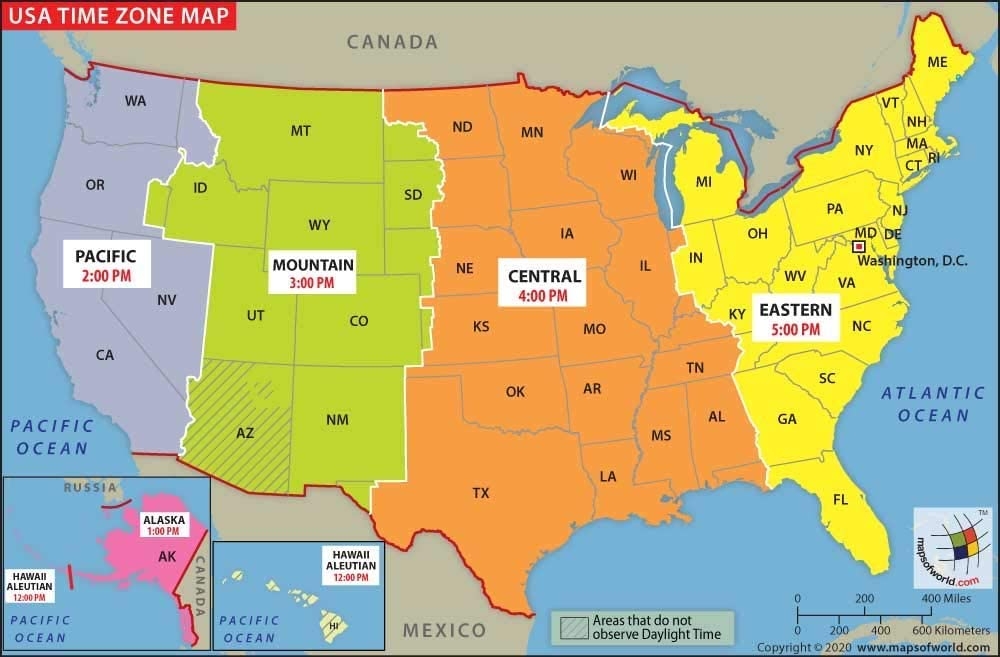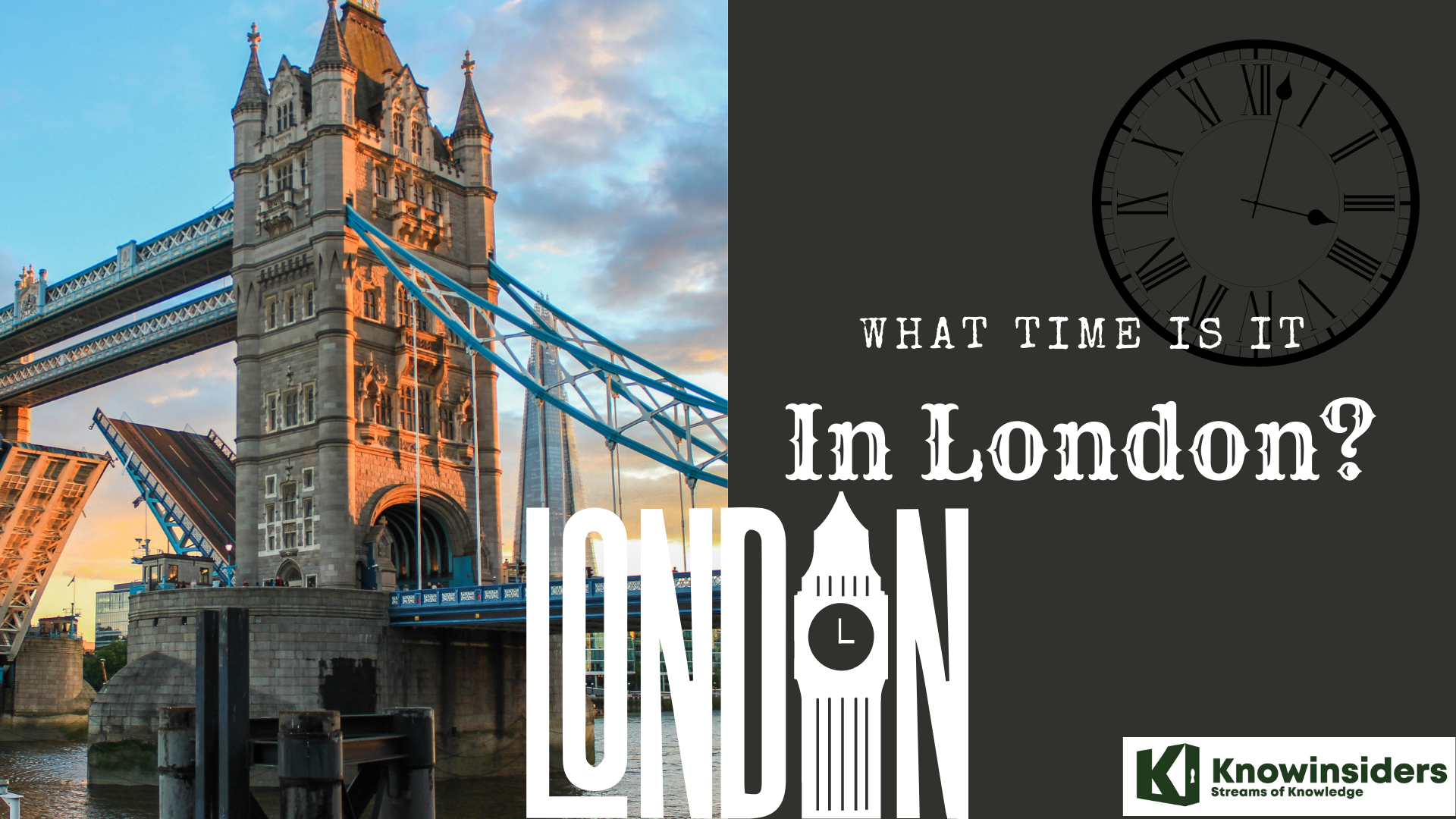How Many Time Zones Are in The US?
 |
| How Many Time Zones Are in The US? |
| Table of Content |
Before the invention of clocks, the time of day was determined by apparent solar time. For example, a sundial was used to estimate the time based on the Sun's apparent position in the sky. When mechanical clocks became common in the 19th century, mean solar time was used. Apparent and mean solar time may differ by up to 15 minutes. Further advances led to the concept of standard time zones. Time zones are regions on the globe that observe the same standard time. The local time in a given time zone is defined by its offset from Coordinated Universal Time (UTC), which is the primary time standard used throughout the world. UTC time either changes backward or forward by one hour for every 15 degrees west or east of the prime meridian.
In the United States, time zones are used to coordinate the time in different states. There are four main time zones across the country, with two other time zones that are used by Hawaii and Alaska. While these six zones are the only ones used in the United States, the entire world is actually divided into 24 different time zones based on longitude. This system helps standardize time in different places and helps people in different time zones coordinate communication, transportation, and much more.
What is a time zone?
A time zone is defined as an area where a uniform standard time applies for legal, economic, and social purposes. Standard time zones are 15 degrees of longitude wide.A time zone is ideally one of 24 spherical lunes (a section on the globe in a north/south direction) with equal width (15 degrees), each assigned with one of the 24 hours (makes together one day and one rotation of the Earth).
Normally, a uniform standard time is maintained in each section to track the day and night cycle. This means that people in each geographic region within a time zone use the same time.
All these zones are defined by an offset from the Coordinated Universal Time (UTC) by a number of hours (UTC−12 to UTC+14) centered on the prime meridian (0°; since 1884 the Greenwich meridian ).
Today's use of time-zones tends to follow more often the boundaries of countries and their subdivisions instead of the standard parallels because it is convenient in close economic or political areas to keep the same time. For example, most of Alaska uses Alaska Time, which spans three standard time zones. The state used two time zones until 1983, when it placed the capital, Juneau, in the same time zone as the more populous Anchorage and Fairbanks.
China spans four time zones but uses only one. The time difference between Bangkok, Thailand, and Kuala Lumpur, Malaysia, is one hour, although the two capitals are on almost the same longitude.
Why Do We Have Time Zones?
Ultimately, time zones grew out of necessity, though their adoption would come gradually throughout the rest of the world.
In France, for example, Paris was considered the prime meridian until 1911. Time zones were not established in United States law until the Standard Time Act of 1918. The act also established daylight saving time in the nation. By the 1920s, many countries throughout the world would start using time zones. In 1972, Coordinated Universal Time (UTC) replaced GMT as the world’s time standard, and we continue to use time zones to this day.
The United States Time Zone History
Before the U.S. had time zones, how did people traveling across the country know what time it was? Until the invention of the railway, it took such a long time to get from one place to another, that local "sun" time could be used. When traveling to the east or to the west, a person would have to change his or her watch by one minute every 12 miles in order to always have the correct time.
When people began traveling hundreds of miles in a day by train, calculating the time became a problem. Railroad lines needed to create schedules for departures and arrivals, but every city had a different time!
At first, the railroad managers tried to address the problem by establishing 100 different railroad time zones. With so many time zones, different railroad lines were sometimes on different time systems, and scheduling remained confusing and uncertain.
Finally, the railway managers agreed to use four time zones for the continental United States: Eastern, Central, Mountain, and Pacific. Local times would no longer be used by the railroads. The U.S. Naval Observatory, responsible for establishing the official time in the United States, agreed to make the change. At 12 noon on November 18, 1883, the U.S. Naval Observatory began signaling the change.
As Greenwich Mean Time (the official time used by the U. S. Naval Observatory) was transmitted by telegraph, authorities in major cities and managers of the railroads reset their clocks. All over the United States and Canada, people changed their clocks and watches to match the time for the zone they lived in. Quickly, the confusion caused by the many different standards of time was resolved.
How Many Time Zones Are There in the US?
 |
| Photo: amazon |
There are 9 time zones by law in the USA and their dependencies. However, adding the time zones of 2 uninhabited US territories, Howland Island and Baker Island, brings the total count to 11 time zones.
The contiguous US has 4 standard time zones. In addition, Alaska, Hawaii, and 5 US dependencies all have their own time zones. As neither Hawaii nor the 5 dependencies use Daylight Saving Time (DST), there are only 6 corresponding DST time zones.
What is A 12th Time Zone?
Since Howland Island and Baker Island constitute the world's westernmost landmasses in relation to the International Date Line, making them the last places on Earth where any date exists, they are sometimes assigned a theoretical 12th-time zone called Anywhere on Earth (AoE).
U.S. Daylight Saving Time
In the United States, Daylight Saving Time begins at 2 a.m. on the second Sunday in March and ends at 2 a.m. on the first Sunday in November. Two states don't observe daylight saving time, Arizona and Hawaii.
Which time zone do you live in?
Hawaii-Aleutian Time Zone
The Hawaii-Aleutian Time Zone derives its name from two areas: Hawaii and the Aleutian Islands in Alaska. These two areas do not use daylight saving time. The time zone observes Hawaii-Aleutian Standard Time (HAST), which is obtained by subtracting 10 hours from UTC (UTC-10:00). Some of the major metropolitan areas under this time zone include Honolulu, Hilo, and Kapaa.
Alaska Time Zone
The Alaska Time Zone encompasses almost the entire state of Alaska. Standard time is observed in this time zone by subtracting 9 hours from UTC (UTC-09:00) and 8 hours during DST (UTC-08:00). The clock time in the Alaska Time Zone is based on the mean solar time at 135 degrees west of Greenwich Observatory.
Pacific Time Zone
The Pacific Time Zone (PT) encompasses the western states of the US, western Mexico, and western Canada. The standard time within this zone is observed by subtracting 8 hours from UTC (UTC-8). During DST, an offsite time of UTC-7 is used. PST is one hour ahead of Hawaii and Alaska Time Zones, and at least one hour behind the other time zones.
Mountain Time Zone
The Mountain Time Zone (MT) observes standard time by subtracting 7 hours from UTC (UTC-07:00) and 6 hours during DST (UTC-06:00). In the US, this time zone is generally known as Mountain Time (MT). Five states, namely Colorado, New Mexico, Wyoming, Utah, and Montana, are included within the Mountain Time Zone.
Central Time Zone
The Central Time Zone (CT) encompasses nine states in the US, the Canadian province of Manitoba, and most of Mexico. It is observed by subtracting six hours from UTC (UTC-06:00). Most of the zone uses DST during summer and changes to Central Daylight Time (CDT), which is 5 hours behind UTC.
Eastern Time Zone
The Eastern Time Zone (ET) encompasses most of the 22 states in the eastern United States. Places within this time zone are 5 hours behind UTC. The northern part of ET is advanced by one hour to 0300 hours EDT at 0200 hours EST on the first Sunday of March. On the first Sunday of November, the time is moved back by one hour at 0200 hours EDT to 0100 hours EST.
Which states have more than one time zone?
 |
| Photo: sporcle |
Alaska
Most of Alaska is in the Alaska Time zone (UTC − 9 h). The Aleutian Islands, a chain of volcanic islands extending southwest from the Alaska Peninsula, are in the Hawaii–Aleutian Time Zone (UTC − 10 h).
Arizona
For about half a year, all of Arizona is in the same time zone, Mountain Time (UTC - 7 h), but the state does not observe Mountain Daylight Time (UTC - 6 h); only the Navajo Nation in the northeastern part of the state does.
Florida
Florida is in two time zones. The western part of Florida (the panhandle south of Alabama) is in the Central Time zone (UTC − 6 h); the rest of the peninsula uses Eastern Time (UTC − 5 h).
Idaho
Idaho is split into two time zones; the northern part observes Pacific Time (UTC − 8 h), Southern Idaho uses Mountain Time (UTC − 7 h).
Indiana
Most of Indiana is in the Eastern Time zone (UTC − 5 h); only some counties in its western corners adhere to Central Time (UTC − 6 h).
Kansas
Most of Kansas has Central Time, with only the four counties of Sherman, Wallace, Greeley and Hamilton on the Colorado border having Mountain Time.
Kentucky
Eastern Time is in effect in about 60% of Kentucky; the rest in the west observes Central Time.
Michigan
Most of Michigan is in the Eastern Time Zone (UTC − 5 h), with only four counties (Gogebic, Iron, Dickinson, and Menominee) bordering Wisconsin in the southern part of the Upper Peninsula having Central Time.
Nebraska
The western third of Nebraska lies in the Mountain Time zone, the eastern two-thirds in Central Time.
Nevada
Nevada is located in the Pacific Time Zone. The town of West Wendover is the only part of Nevada that is legally in the Mountain Time zone, as it is closely associated with Utah.
North Dakota
Up to about the Missouri River, North Dakota's southwestern corner is in the Mountain Time zone. The eastern part of the state is in the Central Time Zone.
Oregon
While most of Oregon is in the Pacific Time Zone, most of Malheur County is on mountain time because it is economically connected to neighboring Idaho.
South Dakota
South Dakota has two time zones. The western part is Mountain Time, while the larger eastern part is in the Central Time Zone.
Tennessee
There are two different time zones in Tennessee. The larger western part is in the Central Time Zone, while East Tennessee in the Appalachian Mountains is located, except for three counties, in the Eastern Time Zone.
Texas
Almost everything in Texas is in Central Time; only two counties in one corner of the west, El Paso and Hudspeth observe Mountain Time.
Weirdest time zone facts in the US
The patchwork of Arizona
Arizona is the only mainland US state that chooses not to observe daylight saving time (DST) — it operates on UTC-7 all year round and has done since 1968. The reason for this is that it’s such a hot place, and putting the clocks forward in the summer would make Arizona evenings even warmer and more uncomfortable. Sounds sensible enough.
But then there are the Native American reservations in Arizona, one of which, the Navajo Nation in the state’s northeast corner, does observe DST. This is in keeping with the parts of the reservation that spill over into neighboring Utah and New Mexico, meanwhile, it means that the land area of around 71,000 square kilometers is one hour ahead of the rest of Arizona in the summertime.
The complexity doesn’t stop there. The Hopi Reservation, comprised of two enclaves within the Navajo Nation, conforms with Arizona by not observing DST. And in turn, there’s a small Navajo exclave in the east of the Hopi Reservation which, yes, observes DST in accordance with the rest of the Navajo Nation. If you took a summer road trip through these reservations and their enclaves and exclaves, you’d have to set your clock forward and backward a total of six times.
The ends (or beginnings?) of the earth
The international date line is an imaginary boundary down the Pacific Ocean that separates two consecutive calendar days. In theory, the time zones immediately on either side of the dateline are UTC-12 and UTC+12. But of course, against all logic, it doesn’t quite work like this.
Take Samoa. Part of the western hemisphere in solar terms, the island nation operated on UTC-11 until 2011. This is when the country skipped over December 30 altogether as the dateline was redrawn, putting it in the “east” on UTC+13 so that it could be closer in time to Australia and New Zealand for economic reasons. Neighboring American Samoa was left behind on the other side of the dateline, and now the two territories are 24 hours apart, despite being only some 150 kilometers away from each other.
If UTC+13 sounds like a bit of a bizarre cop-out, Kiribati takes it to the extreme, with part of the country operating 14 hours ahead of UTC. Kiribati’s time zone choice makes it the first place on the planet to celebrate New Year. What’s more, it means that every day, briefly, there are three calendar days going on at once: if it’s midnight on Wednesday in eastern Kiribati, it’s 11:00 on Tuesday in Central Europe, and 23:00 on Monday in American Samoa.
 What Time Is It In London: Time Zone, Time Difference and Clock What Time Is It In London: Time Zone, Time Difference and Clock Check out the detailed guide on London's time zone, time difference and clock. What time is it in London? |
 What Time Is It In Hawaii? What Time Is It In Hawaii? How many time zones and what time is it in Hawaii? Scroll down to explore the information about time in Hawaii |
 How to Set Multiple Time Zone Clocks on Window 10? How to Set Multiple Time Zone Clocks on Window 10? Multiple time zones are important for those who deal with people across the world due to work or study. Check out our simple steps to ... |























